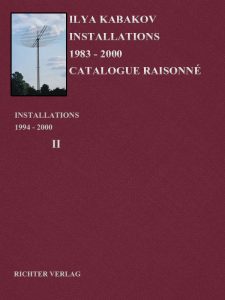In the Closet
YEAR: 1997
CATALOG NUMBER: 115
PROVENANCE
Version 1
Collection Kokerei Zollverein Essen, Essen (as part of The Palace of Projects).
Version 2
Collection Museum van Hedendaagse Kunst Antwerpen, Antwerp, since 1998.
Version 3
Collection of the artist.
Version 4
Private collection, Paris.
EXHIBITIONS
Version 1
The Roundhouse, London (Organization: Artangel), United Kingdom
Ilya & Emilia Kabakov: The Palace of Projects, 23 March – 10 May 1998 (as part of The Palace of Projects, No 117).
Upper Campfield Market, Manchester, United Kingdom
Leaving Tracks. Artranspennine 98. An Exhibition of International Contemporary Visual Art. Ilya & Emilia Kabakov, Upper Campfield Market, Manchester, 23 May – 16 August 1998 (as part of The Palace of Projects, No 117).
Palacio de Cristal del Retiro, Museo Nacional Centro de Arte Reina Sofía, Madrid, Spain
El palacio de los proyectos, 10 December 1998 – 30 April 1999 (as part of The Palace of Projects, No 117).
Version 2
Museum van Hedendaagse Kunst Antwerpen (M HKA), Antwerp, Belgium
16 Installaties, muhka, 17 April – 23 August 1998 (as part of No 120, 16 Installations, Room 8).
Version 3
Städelsches Kunstinstitut, Frankfurt am Main, Germany
Innenleben. Die Kunst des Interieurs. Vermeer bis Kabakov, 24 September 1998 – 10 January 1999.
Version 4
New York, United States
In the Closet, Public Art Fund, 15 June – 13 July 2000.
Galerie Thaddaeus Ropac, Paris, France
Positions: Georg Baselitz, Ilya Kabakov, Maurizio Nannucci, 12 September – 7 October 2000.
DESCRIPTION
The installation is arranged in the foyer of some establishment in a neutral space or in a walkway or wide corridor in a museum – precisely in a place where there is no ‘artistic’ object whatsoever or where a work of art is totally unexpected. The space around it must be intentionally neutral, ‘blank’ – and hence the ‘effect’ of the arbitrary installation will be greater since it will function in contrast to the surrounding environment.
The viewer, walking through such a place, sees an old closet built into the wall, one door of which is slightly ajar. The built-in closet should attract attention precisely because of its old, worn appearance as compared to the ‘modern’ white space of the wall, especially if there is absolutely nothing all around. Furthermore, the sign hanging nearby and the half-opened door of the closet also attract attention.
When the viewer opens both halves of the closet, to his great surprise he sees a table on which the ‘inhabitant’ eats, a corner for dishes, and a light-bulb for reading burns above a narrow bed. Everything in this residence is very crowded, not very practically arranged: clothing, books, even paintings on the walls – it is clear that everything is intended for a long and comfortable life. The whole idea of the installation becomes immediately obvious to the outside viewer: the person who has settled into the closet has hidden precisely from such curious people as the viewer, he has fled from that life in which all of us are submerged from morning until night, he wants to disappear, to hide from the hustle and bustle and noise of the corridor which we are walking along. He would like to attain solitude and peace – but his peace and solitude are doomed since anyone can peer into his life no matter how securely he might lock the door of his closet.
And perhaps he would like to occupy that very position highly desired by all of us – to be near to others, to listen to someone else’s life, but not to participate in it, all the while preserving himself, his seclusion? Perhaps he crawled into the closet on purpose in order to maintain that harmony in this strange way: to be with everyone and yet be alone?
Images
Literature




